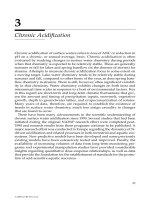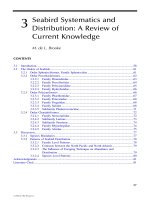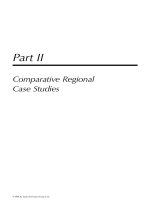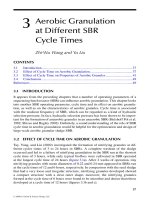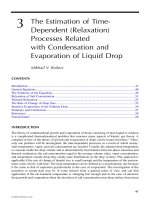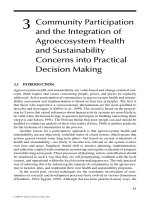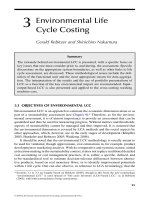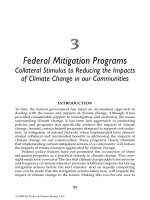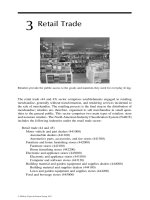CRM Unplugged Chapter 3 pot
Bạn đang xem bản rút gọn của tài liệu. Xem và tải ngay bản đầy đủ của tài liệu tại đây (225.28 KB, 26 trang )
CHAPTER
3
Strategy First:
Aligning CRM with
Company Strategy
Using an Analytical Framework for Defining
Strategy 56
Distinguishing Competitive Advantage from
Other Types of Benefits 59
How Competitive Advantage Manifests Itself
in Operations 63
Identify CRM Initiatives That Fortify
Competitive Advantage 66
Key Points 76
c03.qxd 3/10/04 4:50 PM Page 53
c03.qxd 3/10/04 4:50 PM Page 54
55
A
s introduced in Chapter 1, CRM efforts that are not properly
aligned with company strategy will likely produce efficiency
and other gains in operational effectiveness but rarely improve com-
petitive advantage. In many of these cases, the gains will not justify
the investments made to achieve them. It is important to keep in
mind that lasting gains in revenue, market share, and customer satis-
faction can come only through strengthening the organization’s advan-
tages in the marketplace. CRM initiatives that fortify or enhance
sources of competitive advantage have the best chance for significant
and lasting returns.
Unfortunately, most initiatives designed to improve customer
operations are either unaligned or improperly aligned to company
strategy. This often happens because the strategy is unclear or simply
not widely understood within the company.Although this book is not
specifically about creating or communicating business strategies, we will
show that successful CRM depends on clear and well-understood
company strategy.To help demonstrate a successful approach for link-
ing CRM to strategy, we use Harvard Professor Michael Porter’s
widely accepted strategy frameworks
1
to illustrate the three critical
factors you can use to properly align CRM with your company’s
strategy:
c03.qxd 3/10/04 4:50 PM Page 55
1. Distinguish competitive advantage from pure efficiencies and
other forms of operational effectiveness.
2. Identify the firm’s competitive advantages.
3. Define initiatives that build or enhance the firm’s sources of
competitive advantage.
Leveraging Porter’s well-established framework, we show how
organizations can bring rigor to identifying and evaluating invest-
ments in improving customer operations.
Using an Analytical Framework for
Defining Strategy
In most companies, few people outside the executive inner circle can
articulate the firm’s propositions to the marketplace. To make matters
worse, some companies don’t have a clear strategy or successive rounds
of merger activity have muddied it. Recent thinking on strategy has
aggravated this trend by encouraging companies to think first in
terms of speed, agility, and efficiency. Yet, without a clear strategic
focus that is well understood and practiced throughout the firm, all
major improvement initiatives—including CRM—are unlikely to
produce long-term results.
By contrast, the lasting performers carve out a focused and
unique position within their industry. While, in most cases, they are
very efficient companies, their true sources of advantage are more
subtle. These innovative companies have not simply tried to outrun
rivals, but have chosen to redefine the race or to run a different race
altogether. For example, to achieve price leadership, Southwest
56
CRM Unplugged
c03.qxd 3/10/04 4:50 PM Page 56
Airlines runs in the smaller-metro, shorter route, low-budget traveler
race. It doesn’t try to serve every big market and cover every route.
As a result, it delivers annual profitability far above airline industry
norms. At first, Southwest saw the race so differently than rival air-
lines that they considered their main competitors to be rail and bus
services!
In order to establish a common language for the discussion around
identifying strategic advantages, a brief recap of Michael Porter’s ana-
lytical approach to strategy is required. In his frameworks, a company
can consistently outperform rivals only if it establishes and maintains
a unique strategic position. This value proposition must be coupled to
a competitive scope that refers to the target set of customers. At the
broadest level, there are two types of proposition: delivering the same
value as competitors at lower costs (cost proposition) or providing
some unique mix of value (differentiation proposition). Superior
profitability follows as lower costs translate to higher margins for cost
leaders, and greater value allows companies with differentiation propo-
sitions to charge higher prices.
2
Exhibit 3.1 shows the four generic
strategies based on competitive scope and type of value proposition
(cost or differentiation).
Wal-Mart and Southwest are good examples of companies fol-
lowing low cost strategy (each with a different competitive scope).
Walgreen’s
differentiates
with a broad competitive scope by providing
high levels of convenience to its customers through handy locations
and fast prescription pick-up, drive-through, and online options.
Highly successful mortgage lender Option One (a division of H&R
Block) targets only subprime customers with its differentiated system
of service and brokerage. Discipline and time is needed to build these
57
Strategy First: Aligning CRM with Company Strategy
c03.qxd 3/10/04 4:50 PM Page 57
sustainable marketplace positions. Companies failing to pick and stick
to a focus cannot create a strategic identity and meaningful position
in the minds of customers.
Many CRM shortfalls are predestined by failure to link
CRM goals to the firm’s strategy.Without a well-established
and well-articulated competitive strategy, CRM can produce
only gains in efficiencies and other operational improve-
ments. These types of improvements are necessary to avoid
disadvantage in the marketplace, but do not translate to
enduring advantages.
58
CRM Unplugged
Exhibit 3.1
Target Market and Value Proposition
1. Cost Leadership 2. Differentiation
3a. Cost Focus 3b. Differentiation
Focus
NARROW TARGET BROAD TARGET
LOWER COST DIFFERENTIATION
COMPETITIVE ADVANTAGE
COMPETITIVE SCOPE
c03.qxd 3/10/04 4:50 PM Page 58
59
Strategy First: Aligning CRM with Company Strategy
Distinguishing Competitive Advantage from
Other Types of Benefits
In embarking upon CRM initiatives, many firms have confused the
goal of improving the general effectiveness of operations with gain-
ing competitive advantage. They did not clearly distinguish up-front
which investments were being made to maintain acceptable Best
Practices, versus those made in areas of the business that further
strengthen the firm’s unique position. As a result, most investments
have resulted in operational improvements that, while sometimes
important, are unlikely to produce significant top- or bottom-line
gains. Expending too much effort on these types of changes prevents
the firm from pursuing improvements that will have a greater impact
on competitive advantage.
Without properly understanding and considering competitive
advantage, decisions to improve operations are purely based on what
Michael Porter calls
operational effectiveness (OE)
. This is an umbrella
term describing the attainment and extension of operational Best
Practices and standards that are needed to operate within an industry.
OE includes employing the most up-to-date equipment, inputs,
information technology, and management techniques to improve
products and processes. OE includes, but is not limited to, efficiency
improvement. It also includes time-to-market, speed, reliability, and
certain expected levels of service. For example, to provide full service
to a broad customer set, airlines such as United and American believe
OE includes state-of-the-art frequent-flier programs and on-board
entertainment. These airlines believe that these services are necessary
in order to meet basic customer expectations for a full-service airline.
c03.qxd 3/10/04 4:50 PM Page 59
60
CRM Unplugged
In other words, in this area of the business, they believe this is where
the OE bar has been set, and that they need this minimum level of
service in order to avoid a significant
disadvantage
in the marketplace.
However, OE does not create lasting competitive advantage since
competitors usually quickly match these types of improvements. Busi-
ness improvements (such as CRM) result in competitive advantage
only when they lower costs for cost leaders, or strengthen or further
distinguish unique activities for differentiators. Indeed, within Porter’s
frameworks, successful strategy is judged by its ability to produce and
sustain a long-term return on investment that is superior to rivals,
which means producing and sustaining higher profitability.
Exhibit 3.2
Superior Long-Term Return on Investment
Southwest
TWA
Continental
US Airways
Delta
United
American
-5
0
5
10
Operating income/assets, 1988–1995 (%
)
AIRLINE INDUSTRY
c03.qxd 3/10/04 4:50 PM Page 60
Exhibit 3.2 shows the superior long-term return on investment
(ROI) performance of Southwest Airlines, one company example
referenced in this book. For CRM to be used as a competitive tool,
it must be aimed at helping to improve long-term ROI. This is
achieved only through strengthening competitive advantages so that
lasting profitability improvements are made.
Of course, some level of continuous OE improvement is neces-
sary to ensure the company is attaining acceptable levels of perform-
ance in each area of the business, but the lion’s share of investments
should go toward those areas that fortify company strategy. Exhibit
3.3 depicts the difference between OE and strategic positioning.
61
Strategy First: Aligning CRM with Company Strategy
Exhibit 3.3
Operational Effectiveness versus Strategic Positioning
OPERATIONAL
EFFECTIVENESS
STRATEGIC
POSITIONING
Assimilating, attaining,
and extending BEST
PRACTICES. Updating
management techniques,
technology, equipment, etc.
Offering essentially the
SAME PRODUCTS/
SERVICES as competitors,
only BETTER
RUN THE SAME
RACE FASTER
Creating a UNIQUE
and SUSTAINABLE
competitive POSITION
in the marketplace
Focusing on a DISTINCT
combination of ACTIVITIES
that enhance strategic
position and ultimately
create competitive position
CHOOSE TO RUN A
DIFFERENT RACE
c03.qxd 3/10/04 4:50 PM Page 61
This point is critical for CRM: Many CRM investments will
improve OE, but priority should be given to those that produce com-
petitive advantage. Expensive efforts that result only in OE improve-
ments are unlikely to produce a return on the investment. Furthermore,
at the same time there is an opportunity cost of not pursuing those
elements of CRM that can fortify a firm’s competitive strengths.
If pursued blindly, OE leads to competitive convergence, where
companies get sucked into a never-ending game of catch-up. The
negative experience of most Japanese companies over the past few
decades typifies the dangers of competitive convergence. In the 1980s,
it became obvious that Japanese companies were so good at producing
identical goods more efficiently that it became extremely difficult for
U.S. companies to compete. The Japanese opened an OE gap as
innovations like
Total Quality Management
(TQM) and
Just-In-Time
(JIT) inventory management accelerated the speed and lowered the
cost at which high-quality goods could be produced. U.S. firms swung
into action to close the gap: Companies like Ford Motor, Harley
Davidson, HP, and others embraced Japanese quality initiatives. As
U.S. companies began to regain lost market share, many Japanese
companies—especially those that lacked a long-term competitive
strategy—began to struggle as their efficiency advantages eroded.
A few Japanese firms like Sony performed better because they
had continuously operated efficiently and maintained strategic focus.
Even as they became more efficient, the Japanese companies, and the
many U.S. companies that emulated them, failed to create a distinc-
tive position in the marketplace.Widespread efficiency improvements
were ultimately passed through as lower prices to customers, who
could not tell one company’s goods from another.
62
CRM Unplugged
c03.qxd 3/10/04 4:50 PM Page 62
63
Strategy First: Aligning CRM with Company Strategy
In general, in Japan and the United States, the eventual winners
were companies that carved out and continually fortified a strategic
focus, while maintaining acceptable levels of OE.
3
CRM should be used to help maintain acceptable levels of OE on
the customer side of the business. After all, a poorly operated customer
service call center or poorly kept customer records would lead to a dis-
tinct disadvantage for most companies. But in most cases these improve-
ments will be very similar to those pursued by rivals, and so it is equally
important that CRM is used to strengthen competitive advantage for
the organization in the marketplace. In summary, CRM can be used
to provide both OE and competitive advantage. In defining CRM
investments, it is important to be able to distinguish between them.
How Competitive Advantage Manifests Itself
in Operations
Having established the importance of competitive advantage to the firm
and to CRM initiatives, it is important to clarify how competitive
advantage is produced within the firm. In terms of daily operations,
what distinguishes firms with competitive advantage from those
without it? Michael Porter’s research tells us that companies with
competitive advantage tend to have distinct value chains. Ultimately,
price and cost differences between companies derive from the many
policies, processes, and activities that go into designing, producing,
and delivering the firm’s products or services. Cost is generated by
these activities and lower-cost strategies are achieved by executing
them more efficiently.To create greater value,
differentiators
must perform
different activities or conduct them in different ways.
c03.qxd 3/10/04 4:50 PM Page 63
The value chain differences are not manifested in one or two
activities but are built up across a large number of functions through-
out the firm. Competitive advantage comes from the sum of these
differences,
4
and successful companies proliferate them throughout
their organizations.
So successful companies are actually collections of activities within
which competitive advantage resides. Competitive advantage is the
s
um of the differences
—compared to rivals—in the way things are
done at the nuts-and-bolts level of the business. If the competitive
advantage is not reflected within the activities of the firm, the strategy
will not be executed properly. If the differences are not widespread
or pronounced enough, competitive advantage will not be sustained.
Let’s look more closely at Southwest Airlines. As noted, they are
the low-fare airline, targeting customers who typically take short
trips and seek bargain fares. Southwest has meticulously developed a
unique model that provides a much lower cost-per-passenger mile
than any rival. It flies mostly to less-congested secondary airports. By
flying only one type of plane, Southwest reduces its training and main-
tenance costs. The smaller airports and planes help Southwest pro-
duce faster gate turns that increase aircraft utilization and on-time
performance. Its lean gate crews turn planes around faster and, in
return for higher pay, award Southwest with more flexible union con-
tracts. It doesn’t fly internationally, interchange baggage with other
airlines, or offer in-flight meals. It has only one class of service.
The simple, down-to-earth, no-frills approach of Southwest
Airlines is designed to support its low-fare value proposition. If cus-
tomers want additional services, they can pay more to fly on other
airlines.What Southwest lacks in amenities it tries to make up some-
64
CRM Unplugged
c03.qxd 3/10/04 4:50 PM Page 64
65
Strategy First: Aligning CRM with Company Strategy
what in style. For example, the airline screens new hires to ensure that
friendly personal service dominates the company culture. Southwest
consistently ranks at the top of its industry in customer satisfaction:
In the first quarter of 2003, the American Consumer Satisfaction
Index gave Southwest a 75 out of 100 versus the industry average of
67.
5
Flying Southwest is fun and customers love it!
Southwest’s unique business model can be depicted as a highly
interconnected system of activities, processes, policies, and behaviors.
Exhibit 3.4 shows what Michael Porter calls the
activity system
.The
larger circles represent the activities that are central to Southwest’s
Exhibit 3.4
Southwest Airlines Activity System
Limited
passenger
service
Frequent,
reliable
departures
Lean, highly
productive
ground
and gate
crews
High
aircraft
utilization
Very
low ticket
prices
Short-haul,
point-to-point
routes between
medium-sized
cities and
secondary
airports
No
meals
No seat
assignments
No
connections
with other
airlines
No
baggage
transfers
Limited use
of travel
agents
Automatic
ticketing
machines
Standardized
fleet of 737
aircraft
15-minute
gate turns
High
employee
compensation
Flexible
union
contracts
High
employee
stock
ownership
“Southwest,
the low-fare
airline”
c03.qxd 3/10/04 4:50 PM Page 65
66
CRM Unplugged
uniqueness. The diagram is useful in showing how these activities
relate to each other and how all activities take their cue from these
unique approaches.
It is vital to think about sources of competitive advantage in terms
of the enterprise-wide system of activities, processes, polices,and behaviors.
By understanding the full picture, any strategic initiative—including
CRM—can be better targeted to enhance the firm’s advantages.
Identify CRM Initiatives That Fortify
Competitive Advantage
As we have seen, CRM can be used both to improve operational
effectiveness and enhance competitive advantage. The first step in
determining which CRM initiatives to invest in is to determine
which type of goal is to be pursued.We have seen that OE improve-
ments are quickly matched by competitors. In contrast, creating
enduring advantages in the marketplace leads to permanent gains in
market share, price premiums, or cost advantages.
6
There are typically two key types of goals in planning a CRM
initiative:
1. Improve long-term ROI by strengthening the firm’s compet-
itive advantages, and
2. Maintain acceptable levels of operational effectiveness in all
key processes and activities.
For significant and lasting top- and bottom-line gains, CRM
efforts should focus chiefly on improving long-term ROI.
c03.qxd 3/10/04 4:50 PM Page 66
67
Strategy First: Aligning CRM with Company Strategy
A critical element to consider while planning any CRM initia-
tive is that strategies are typically formulated at the business-unit
rather than the global level within the firm. This means each unit
likely competes in a different industry, with a different competitive
proposition and scope. Each has its own uniquely tailored value
chain. There are many shared services provided by the umbrella cor-
poration, but it is unlikely that these are sources of competitive
advantage to the units.
Corporate guidelines and leadership are required in the execu-
tion of enterprise CRM projects, but one size almost certainly does
not fit all when it comes to the business units. Failure to define CRM
agendas tailored for each business unit is a major reason for failure of
these initiatives
We have seen how the activity system is a useful tool for under-
standing the interconnected web of policies, processes, and activities
that constitute a firm’s competitive advantage. By mapping your
unique activities—and how the entire system of activities produces
competitive advantage—CRM initiatives can be formulated that
strengthen your firm’s unique activity system.
For example, the highly successful subprime mortgage lender
found that activity-system mapping clarified the importance of the
company’s service culture and broker network. Many unique policies
and processes within both areas contribute to the firm’s competitive
strengths in the marketplace. CRM improvements were designed to
enhance these areas of competitive strength and purposely did not
include many traditional areas—such as sales force automation—
where many companies traditionally invest.
c03.qxd 3/10/04 4:50 PM Page 67
68
CRM Unplugged
The mortgage lender’s focus ensured that the best customers
received unique and preferred treatments throughout each depart-
ment of the firm. To do this, brokers used a customer-profitability
measurement system that contained built-in customer-performance
visibility. This type of focused attention to individual customers and
customer segments is a characteristic found among the leading com-
panies. They understand their advantages and create processes that
enhance the benefits of their unique situations.
The CRM ideas that fortify strategy are typically different for
each firm. However, our experience shows that they typically fall
within five broadly defined categories:
1. Improve customer selection
2. Deliver enhanced value to customers
3. Coordinate customer interactions
4. Tailor customer-specific interactions
5. Capture feedback
Improve Customer Selection
Successful CRM requires the implementation of processes for seg-
menting customers and measuring performance of these segments.
The capture of data from customer interactions allows the firm to
build a profile of lucrative customer types. How these types of cus-
tomer segments were attracted and retained provides guidance to the
sales and marketing functions in attracting additional customers with
similar attributes. Improved customer selection fortifies competitive
c03.qxd 3/10/04 4:50 PM Page 68
advantages by fine-tuning the firm’s prospecting processes and helps
ensure that resources and efforts are targeted to the most appropriate
prospects for the firm’s value proposition. Achieving this requires
several steps:
1. Defining customer segments, customer metrics, and a perform-
ance measurement process
2. Comprehensive capture of customer-interaction data. This
includes information such as method of sourcing, preferred
methods of buying, frequency of purchases, revenue and prof-
it profile over time, frequency of interaction with each sales
and service channel, and so on
3. Creation of target-prospect profiles and joint planning between
sales and marketing for attracting, retaining, and growing tar-
get prospects
4. Regular management review of segment performance
A typical obstacle to success in implementing CRM is the failure
of sales, marketing, and IT functions to work together to create and
develop opportunities. When properly initiated, sales and marketing
identify the specific data that are required for the analysis of cus-
tomer patterns. IT then captures and organizes it for review.Through
cooperation, the firm’s sales, marketing, and IT departments can
increase effectiveness by selecting the right kinds of customers to suit
the firm’s value proposition. Achieving interdepartmental teamwork
is a major organizational hurdle that each firm must overcome in
order to realize the full benefits of CRM.
69
Strategy First: Aligning CRM with Company Strategy
c03.qxd 3/10/04 4:50 PM Page 69
Deliver Enhanced Value to Customers
As we have seen, CRM provides benefits to organizations by help-
ing to organize and coordinate customer interactions. However, it is
important to realize that CRM can also deliver direct benefits to the
customer. For example, it can facilitate delivery of more accurate and
helpful information during the buying process, or enable the ability
of customers to buy product or receive customer support online.
Rather than simply reaping internal rewards—CRM should be tar-
geted on improving value delivered and the experiences created for
customers.
In planning CRM investments, opportunities exist to enhance
value for customers in ways that strengthen the firm’s advantages. For
example, many cost leaders would find their strategy enhanced through
online customer self-service programs. Similarly, a leading mortgage
lender—which is currently differentiated by speed of service—might
introduce one-hour approvals by linking brokers and web-based loan
channels with automatic underwriting systems. At the basic level,
CRM can enhance competitive advantage by improving customer
operations in ways that strengthen advantages.
Coordinate Customer Interactions
CRM allows firms to better manage and coordinate customer inter-
actions across multiple departments. Applications can keep tabs on
interactions such as orders, service requests, and product inquiries as
they flow through the business. By better understanding the status of
each interaction, wherever it may occur in the firm, an organization
has up-to-the-minute and accurate status. It can also measure the
responsiveness, cycle time, and other service-level metrics.
70
CRM Unplugged
c03.qxd 3/10/04 4:50 PM Page 70
This coordinated approach improves operational effectiveness and
can also boost competitive advantage by providing better integration
between customer interaction activities. One of the hallmarks of firms
with tailored value chains and competitive advantage is the high degree
of “fit” between activities in the value chain. In a broad sense, fit
comes in three forms:
7
1. Consistency between activities
2. Reinforcement of activities
3. Optimization of activities
Consistency between Activities
Ensure that each department and each activity is configured and exe-
cuted with the same overall goal in mind. This is no small achieve-
ment in the highly balkanized environment of modern corporations.
Only the most focused of firms have achieved even this simplest level of
fit. For example, mutual fund provider Vanguard aligns all its activities
to its low cost strategy.
8
It minimizes portfolio turnover and does not
need highly compensated money managers.Vanguard has a direct dis-
tribution approach, eschewing the use of brokers and their associated
commissions.Through tailored compensation plans, it also encourages
employees to continually achieve cost savings throughout the busi-
ness. Consistency across the value chain ensures that the competitive
advantage of activities do not cancel themselves out. It makes com-
municating the value proposition to employees and customers easier,
and the focused approach increases the chances of good execution.
CRM provides important tools for achieving consistency by allowing
for standardized information capture, presentation, and workflow
71
Strategy First: Aligning CRM with Company Strategy
c03.qxd 3/10/04 4:50 PM Page 71
management across activities. It ensures that employees have control
and visibility as work flows from one activity to another.
Reinforcement of Activities
In companies with pronounced strategic advantages, activities are
designed and performed in ways that improve the effectiveness of other
activities. For example, going beyond simple consistency, Neutrogena’s
marketing activities are self-reinforcing.
9
The company invests in
relationships with dermatologists to gain endorsements from the
medical community.At the same time, they distribute product through
upscale hotels, which are keen to co-brand a soap recommended by
doctors. These marketing and distribution activities feed off each other
to reinforce Neutrogena’s mild, medicinal cleansing brand attributes.
Implemented properly, CRM creates reinforcement for the key
activities across the value chain. For example, Walgreen’s stores and
online pharmacy are designed to bolster customer convenience. By
implementing a national customer database, automatically available
to any store, customers can order online and pick up anywhere in the
country—even changing plans at the last minute. Only CRM’s central
data platform and applications, when configured to automate and
integrate disparate sales channels, can provide this functionality. In the
Walgreen’s example, CRM elevates previously separate buying chan-
nel activities into a mutually reinforcing more beneficial whole for
the customer.
Optimization of Activities
Once activities are consistent and mutually reinforcing, leading firms
invest in optimizing them. This could take the form of eliminating
72
CRM Unplugged
c03.qxd 3/10/04 4:50 PM Page 72
redundancy, minimizing wasted effort, improving product design
through better feedback from customers, and designing product or
service plans so that customers can perform certain service activities
themselves. Leading casino operator Harrah’s bases its strategic posi-
tioning on attracting retirees (low-rollers) interested mainly in playing
slots. Harrah’s developed various programs and benefits designed to
attract these customers and keep them loyal. One of these involved
developing at each property a “frequent player” tracking card that
accumulated benefits with increasing play.After the initial introduction
of the card, Harrah’s felt it could significantly enhance this idea by
allowing customers to use their cards at all Harrah’s properties. The
first step was to implement a national database called the Winner’s
Information Network.
10
Analytical tools and models were implemented to help spot pat-
terns in the data. The models and technology were also patented to
protect the innovations. Next steps included training local properties
in using the tools and models.
David Norton,Vice President of Loyalty Marketing at Harrah’s,
said the program has contributed over $100 million of additional rev-
enues since its inception. He also noted that over 70 percent of Harrah’s
revenue is now tracked—meaning that it can be traced to an individ-
ual cardholder. There are currently six million active cardholders.
11
The upshot is that Harrah’s introduced an innovative way to
drive business with its customers and they continue to enhance and
optimize those activities and processes. The more nuanced the pro-
grams become, the harder it is for competitors to emulate them.
12
These sorts of efforts to optimize existing advantages are the
keystone of successful CRM. Too often, CRM implementation takes
73
Strategy First: Aligning CRM with Company Strategy
c03.qxd 3/10/04 4:50 PM Page 73
74
CRM Unplugged
on a Hail Mary flavor when, in fact, simple creative ideas that build
on existing processes are likely to produce bigger long-term gains. To
identify ideas for tailoring and optimizing, Harrah’s used a sophisti-
cated system for gathering and analyzing customer insight. We will
see in the next chapter how these types of approaches work and how
they can be used to drive long-term returns for your company.
Competitive advantage resides in the tightly nested system of
activities with the firm. Activities are designed, integrated, and
implemented to pursue the firm’s strategic themes. The system as a
whole is more important than any individual activity. The sustain-
ability of competitive advantage is based on how difficult (or unde-
sirable) it is for competitors to emulate a rival’s value chain. As shown
in previous examples, the wider, more unique, and deeply nested the
web of activities is, the harder it is for rivals to emulate. This is why
it is critical for firms to continue investing in strengthening its
sources of competitive advantages through initiatives such as CRM.
When embarking upon CRM, it is critical to keep in mind the
firm’s need to continually strengthen strategy. Unless the goal is to
achieve simple gains in operational effectiveness, CRM must serve to
strengthen and optimize the firm’s activity system. It must be imple-
mented in a tailored way, behind a strategic theme that helps further
distinguish the firm’s operations. Most CRM initiatives to date have
failed to approach the opportunity for CRM success in this manner.
Tailor Customer-Specific Interactions
Once customers have been segmented and their value and needs
identified, the firm can begin serving segments (and even individual
customers) in unique ways. This requires implementing unique
c03.qxd 3/10/04 4:50 PM Page 74
policies, processes, and activities based on the needs and values of dif-
ferent customers. By tailoring how customers are treated, the firm
can control the service level and costs associated with each type of
customer. This also allows the firm to build loyalty and gather more
insights into the needs of these customers. For example, the mort-
gage lender described earlier might implement an expedited loan
application and different underwriting rules for its best customers.
Customer-level tailoring can add another layer of uniqueness to the
firm’s distinctive value chain.
With CRM, comprehensive customer-level tailoring is now pos-
sible. CRM provides tools for segmenting customers, measuring value,
capturing insight, and configuring and automating the various tailored
service levels associated with each customer. It also helps to coordi-
nate and integrate differentiated service levels across the enterprise.
Capture Feedback
One of the key benefits of CRM is the ability to capture essential
information from marketing, sales, and service activities. As customers
interact with the firm through person-to-person and electronic
channels, information can be captured, centralized, and organized for
review.After implementing CRM, it is difficult in most organizations
to prioritize action based on the great quantity of information now
available. For firms with clear understanding of their distinct advan-
tages, customer feedback can be prioritized and used to continue
improving the firm’s capabilities and approaches in the areas that
most impact its competitive advantage. Customer feedback is a major
input in the continuing efforts to tailor the firm’s value chain, as well
as to deliver value to individual or segments of customers.
75
Strategy First: Aligning CRM with Company Strategy
c03.qxd 3/10/04 4:50 PM Page 75
Key Points
•
CRM failures are often due to the lack of a clear and
focused company strategy. CRM should not be attempted
if this type of strategy is not in place.
•
CRM can help make customer-related operations more
effective, but this is not the same as creating competitive
advantage. Gains in competitive advantage are measured by
sustained gains in profitability over rivals.
•
CRM creates competitive advantage when it strengthens
the web of policies, processes, and activities that represent
the unique way the company does business, either by mak-
ing it more efficient or emphasizing unique approaches and
methods that lead to greater value.
Notes
1. Michael E. Porter,“What Is Strategy?” Harvard Business Review.
Boston: Harvard Business School Press, November 1, 1996.
2. Ibid.
3. Ibid.
4. Ibid.
5. American Customer Satisfaction Index, May 21, 2003, www.theacsi.org/
first_quarter.htm#air, available as of February 3, 2004.
6. Porter,“What Is Strategy?”
7. Ibid.
8. Ibid.
76
CRM Unplugged
c03.qxd 3/10/04 4:50 PM Page 76
9. Ibid.
10. Gary Loveman,“Diamonds in the Data Mine,” Harvard Business
Review, #R0305H. Boston: Harvard Business School Press, May 1,
2003; and Martha Rogers,“Harrah’s Takes the Gamble Out of
Customer Loyalty,” SearchCRM, June 11, 2002, http://searchcrm.
techtarget.com/originalContent/0,289142,sid11_gci832166,00.htm,
available as of February 3, 2004.
11. Rogers, “Harrah’s Takes the Gamble Out of Customer Loyalty.”
12. Loveman,“Diamonds in the Data Mine.”
77
Strategy First: Aligning CRM with Company Strategy
c03.qxd 3/10/04 4:50 PM Page 77
